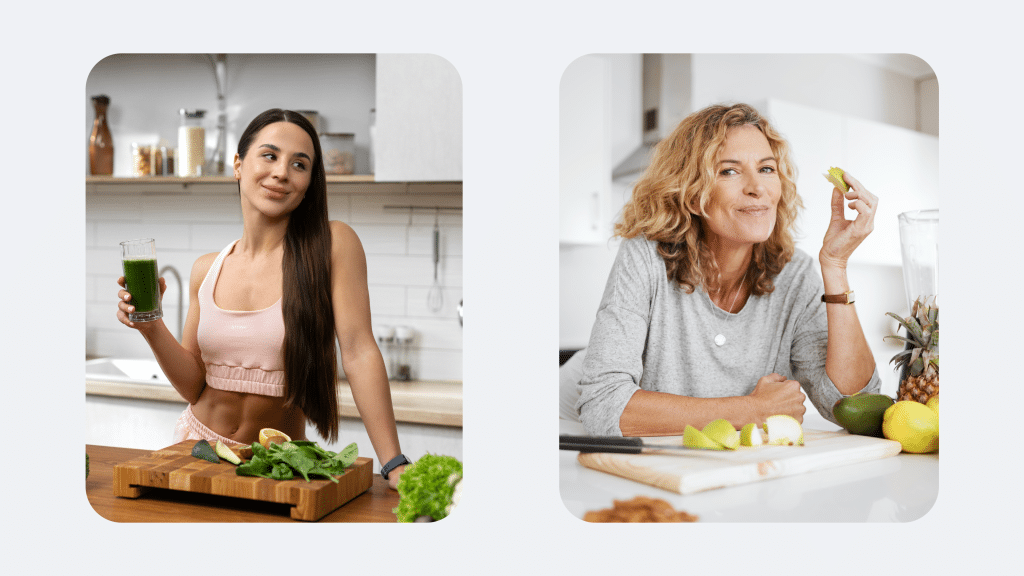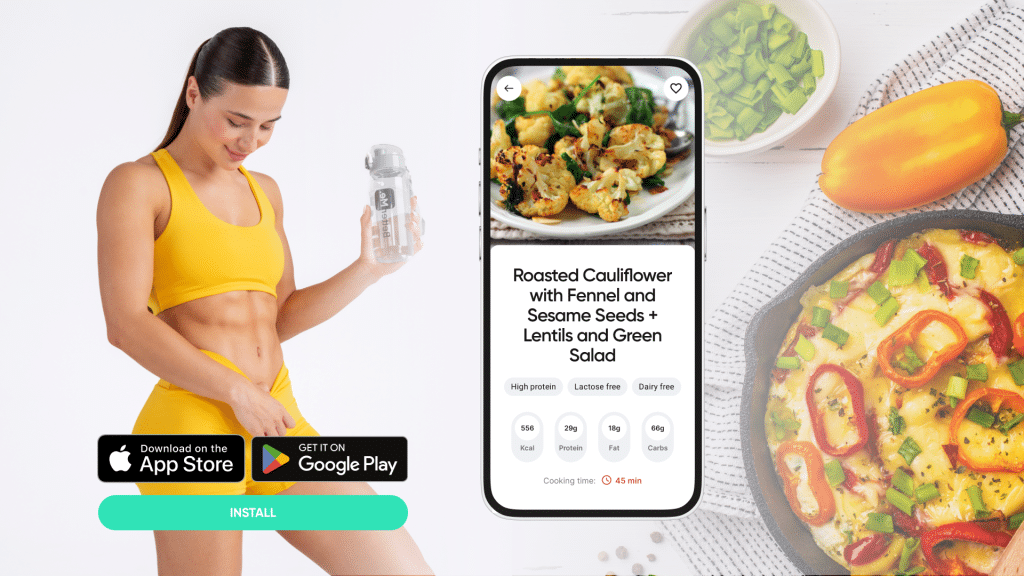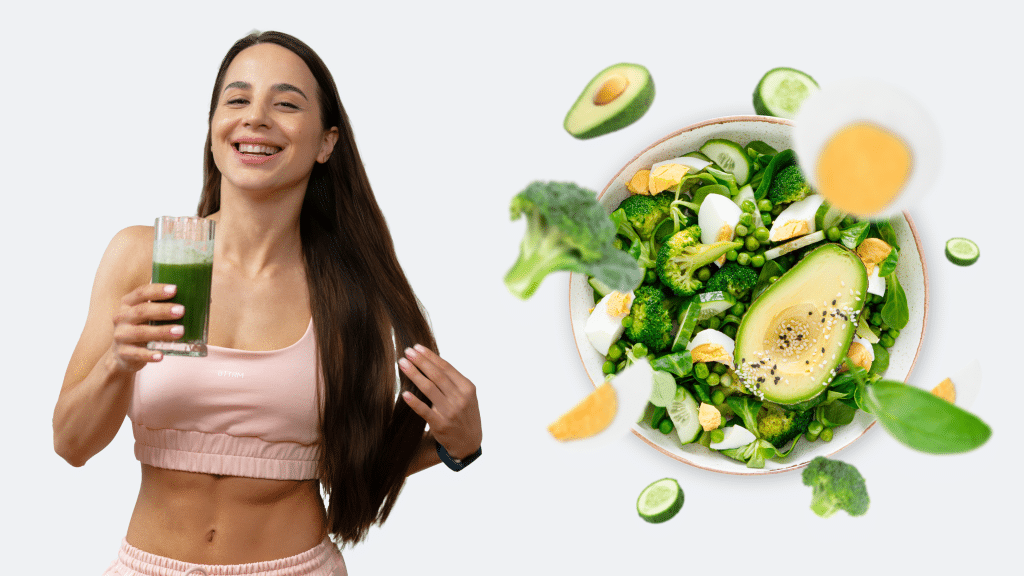Spicy, colorful, and rich in flavor, Indian cuisine is as diverse as the country itself. While there are many healthy dishes to choose from, some traditional favorites can be high in fat and calories.
That doesn’t mean you have to give up Indian food altogether though. Knowing what goes into your food and making smart choices can help you enjoy Indian cuisine without derailing your diet.
Here’s a list of the best and worst Indian foods for your health, along with tips on how to make healthier choices.
What Indian Food Is Healthy?
Healthy Indian foods are dishes made from wholesome ingredients, cooked with minimal oil, and packed with vegetables, lean protein, and whole grains. Grilled or tandoori dishes, lentil-based meals, vegetable curries, whole grains, lean proteins, herbs, and spices are all healthy and nutritious options.
Indian cuisine tends to be heavy on the vegetables and light on the meat. This is good news for your health, as diets that are high in vegetables and low in animal products have been linked with lower rates of heart disease, obesity, cancer, and other chronic conditions (1, 2).
Some of the healthiest Indian foods include:
- Dal
- Chicken tandoori
- Raita
- Aloo gobi
- Kebabs
- Chilla
- Jalfrezi
- Masala bhindi
- Baingan bharta
- Idli
- Chaach
- Dhokla
1. Dal
Dishes with dal, or lentils, are a good source of protein, fiber, and complex carbohydrates. These nutrients are essential for maintaining a healthy weight and keeping your energy levels up, and including more of them in your diet may reduce your risk of chronic diseases (3).
2. Chicken Tandoori
In Hindi, “tandoor” means “clay oven”. Chicken tandoori is chicken that’s been marinated in yogurt and spices, then cooked in a tandoor. This cooking method brings out a rich flavor without needing too much oil or butter. Fish and lamb can also be cooked tandoori-style.
3. Raita
Raita is a yogurt-based dish that’s often served as a side or condiment. It can be made with cucumbers, tomatoes, onions, and other vegetables. Adding raita to your meal helps increase the nutrient and antioxidant content. It’s refreshing and cooling, which makes it a perfect complement to spicier dishes.
4. Aloo Gobi
This potato and cauliflower dish is a staple of Indian cuisine. It’s typically made with spices such as ginger, garlic, turmeric, and cumin. These spices have anti-inflammatory properties that may help protect against chronic diseases such as heart disease and cancer (4). This potato-cauliflower combination is also a great source of fiber, potassium, and vitamin C.
Read more: Satisfying Low Sugar Desserts You Won’t Feel Guilty For
5. Kebabs
Meat lovers don’t have to miss out on the health benefits of Indian food. Kebabs, which are grilled or roasted meats, can be a good source of protein and healthy fats.
Just be sure to choose lean cuts of meat and limit your portion size. Grilling or roasting your kebabs on a skewer (rather than frying) helps reduce the amount of fat that’s absorbed during cooking.
6. Chilla
Chilla is the breakfast lover’s answer to pancakes This dish is made with chickpea flour, spices, and vegetables. It’s a good source of protein and fiber, both of which are important for keeping you feeling full and satisfied throughout the day (5).
As a low-carb breakfast option, chilla can help you control your blood sugar levels and avoid midday energy crashes. It may also help your weight loss efforts.
7. Jalfrezi
Jalfrezi is a stir-fry made with vegetables and spices. It’s a quick and easy way to get your daily dose of vegetables. You may also add some lean protein, such as chicken or tofu.
8. Masala Bhindi
Bhindi, also known as okra, is a popular vegetable in India. It’s often cooked with onions, tomatoes, and spices to create a flavorful dish. The nutrient-rich vegetable is an excellent source of fiber, vitamins C and K, and A (6).
The nutrients in this dish, such as fiber, may help manage the symptoms of metabolic syndrome—a condition that’s characterized by high blood pressure, insulin resistance, and obesity (7).
9. Baingan bharta
This eggplant dish is a favorite in Indian households. It’s made by roasting or grilling eggplant, then mashing it with onions, tomatoes, and spices. The final product is a flavorful, nutrient-dense dish that’s perfect for vegetarians and meat lovers alike.
10. Idli
Idli is a traditional South Indian dish that’s made by steaming fermented rice and lentil batter. It’s a good source of protein, fiber, and complex carbohydrates (3). Idli is also low in calories and fat, which makes it a healthy breakfast or snack option.
11. Chaach
Chaach is a type of yogurt-based drink that’s popular in India. It’s made by mixing yogurt with water, spices, and salt. Chaach can help promote the health of your digestive system, thanks to the probiotics in yogurt (8). It’s also a great source of calcium, which is essential for strong bones and teeth.
12. Dhokla
Dhokla is a steamed cake that is made with chickpea flour. It’s a good source of protein and fiber, both of which are important for keeping you feeling full and satisfied throughout the day (5). Dhokla is also low in calories and fat, which makes it a healthy breakfast or snack option.
The Worst Indian Foods for Your Health
While there are many healthy Indian foods to choose from, some dishes are higher in fat and calories than others. These include:
1. Samosas
A samosa is a fried pastry filled with potatoes, peas, and other vegetables. While it may be tempting to eat more than one of these fried delights, they’re high in unhealthy fats and calories. The refined wheat pastry is also lacking in nutrients.
2. Naan
Naan is a type of flatbread that’s often served with Indian food. It’s made with white flour, which is refined and lacking in nutrients. Eating too much naan may contribute to weight gain or spikes in blood sugar levels. Other ingredients such as oil and ghee can make naan high in unhealthy fats (9).
3. Pakora
Pakora is a popular snack made by coating vegetables in chickpea flour and frying them. Similar to samosas, pakoras are high in calories and unhealthy fats.
Making a healthier version at home with chickpea flour batter and baking the pakoras instead of frying them can help reduce some of the negative health effects.
4. Saag Paneer
Don’t let the spinach fool you, this dish is high in calories and fat. Saag paneer is a spinach-based curry that’s made with paneer, a type of Indian cheese.
The cheese adds unhealthy saturated fats to the dish. Whole milk or cream is also often used, which further increases the fat and calorie content. To lighten the dish at home, use low-fat milk or yogurt and tofu instead of paneer.
Want to spring-clean your diet, skyrocket your self-confidence, and shatter your insecurities? Check out the BetterMe: Health Coaching app and set this plan in motion!
5. Butter chicken
Butter chicken is a popular Indian dish that is made with chicken that’s been cooked in a tomato-based sauce. The dish gets its name from the large amount of butter or ghee that’s used to make it.
While butter chicken may be delicious, it’s also high in unhealthy saturated fats, which increase the risk of cardiovascular disease (10). The calorie content is also quite high, which makes it a less-than-ideal choice if you’re watching your weight.
6. Pappadam
Pappadam is a type of fried flatbread that’s popular in India. It’s made with white flour and often served as an appetizer. As with other fried foods, pappadams are high in unhealthy fats and calories. If you’re watching your weight, it’s best to avoid this dish.
7. Gulab Jamun
Gulab jamun is a popular Indian dessert that is made with fried dough balls that are soaked in sugar syrup. While they may be small, these sweet treats pack a lot of calories and sugar. They’re also high in unhealthy fats. If you have diabetes or are watching your weight, it’s best to avoid gulab jamun.
How Healthy Is Indian Food?
There are many delicious and nutritious dishes that can be made using traditional Indian ingredients and methods. Of course, as with any cuisine, there are also some unhealthy choices when it comes to Indian food. However, overall, the health benefits of eating Indian food outweigh the risks.
Some health benefits include:
Gut Health
Daal, a type of Indian lentil soup, is loaded with fiber and other nutrients that are good for gut health. Fiber helps to keep things moving along in your digestive system, preventing constipation and other problems.
Raita, a yogurt-based dish, is also good for gut health. The probiotics in yogurt can help maintain a healthy balance of bacteria in your intestines (8).
Weight Loss
Indian food can be a great way to lose weight, thanks to its emphasis on fresh vegetables, legumes, and spices. Spices like turmeric and cumin may boost metabolism and help burn fat (4).
Vegetable dishes such as dal (lentils) aloo gobi (potatoes and cauliflower) are hearty and filling, but low in calories.
Heart Health
Many Indian dishes are rich in antioxidants, which may help protect your heart health (11). Antioxidants scavenge harmful free radicals from your body and help prevent plaques from forming in your arteries, reducing your risk of heart disease.
Saag, a spinach-based dish, is particularly high in antioxidants. It also contains magnesium, another nutrient that is good for heart health (12).
Magnesium helps keep your blood pressure under control, which lowers the risk of heart attacks and strokes.
Read more: Does BetterMe Work? Here’s What I Found
How to Make Indian Dishes Healthy
To make Indian food healthier, you need to be aware of some unhealthy ingredients and cooking methods. Here are some tips:
- Use less oil: Indian food is often deep-fried. This adds a lot of unnecessary fat and calories to the dish. To make it healthier, cook with less oil and use healthier oils such as olive oil (14).
- Limit the amount of ghee: Ghee is clarified butter that is often used in Indian cooking. It adds a lot of flavor, but is also very high in saturated fat. Use it sparingly (14).
- Avoid cream: Many Indian dishes contain cream which makes them very rich and high in calories. You can either use low-fat alternatives or just avoid using it altogether.
- Choose leaner meats: When making meat-based dishes, choose leaner cuts of meat such as chicken or turkey. You can also remove the skin from chicken to reduce the amount of fat.
- Add more vegetables: Add extra vegetables to your dish to increase the fiber and nutrient content. This will also help fill you up so you don’t overeat (15).
- Watch your portions: When eating Indian food, be aware of the portion sizes. It is easy to overeat when so much delicious food is on offer. Try sticking to smaller portions and you’ll be able to enjoy all the flavours without overindulging.
- Bake instead of fry: If a recipe calls for deep frying, try baking instead. This will make the dish healthier as it will use less oil.
Our previous post, Indian Diet Plan to Lose Weight in 10 Days, features pro tips on how to kickstart your weight loss while enjoying meals from our favorite cuisine.
FAQs
What is the lowest-calorie Indian dish?
One of the lowest-calorie Indian dishes is a plate of stir-fried vegetables, which is known as “sabzi”. This dish contains no added oils or spices, which makes it a healthy and low-calorie option.
Another low-calorie Indian dish is tandoori chicken. This dish is made by marinating chicken pieces in yogurt and spices before cooking them in a clay oven. It’s a healthy and delicious option for those who are watching their calories.
Other low-calorie Indian dishes include:
- Daal (lentil soup)
- Vegetable soup (shorba)
- Raita, a yogurt-based side dish that is made with cucumber, mint, and spices
- Tandoori fish
- Grilled paneer (cottage cheese)
- Chaat (snack) made with chickpeas, yogurt and chutney
- Palak paneer (spinach and cottage cheese curry)
Note that each dish’s calorie count may vary depending on the cooking method and ingredients used.
Is tikka masala healthy?
Tikka masala is a popular Indian dish that consists of marinated chicken pieces cooked in a creamy tomato-based sauce. It’s a healthy option as long as you pay attention to the ingredients and portion size. Here are some tips for making a healthier tikka masala:
- Use lean cuts of chicken or tofu as the protein source
- Substitute cream with low-fat yogurt or light coconut milk
- Use fresh tomatoes or plain canned tomatoes instead of tomato sauce, which often contains added sugars
- Limit the amount of oil used for cooking
- Serve with whole-grain rice or naan bread for added nutrients
Keep in mind that even with these modifications, tikka masala is still considered a higher-calorie dish due to its rich flavors and creamy texture. Enjoy it in moderation as part of a balanced diet.
Why is naan unhealthy?
Naan isn’t unhealthy, but it can be high in calories and carbohydrates. Naan bread is made with wheat flour, yeast, water, and sometimes yogurt or milk. It’s then cooked in a tandoor oven, which gives it its signature fluffy texture.
The main reason naan may be considered unhealthy is due to the added ghee (clarified butter) or oil that is used during the cooking process (9). This adds unnecessary calories to the bread, which makes it a higher calorie option than other types of flatbreads such as roti or chapati.
To make naan healthier:
- Use whole-wheat flour instead of white flour
- Skip the ghee or oil when cooking
- Add herbs and spices for flavor instead of butter
- Serve with healthier options such as grilled vegetables or daal instead of rich curries
Naan can still be enjoyed in moderation as part of a balanced diet. Just be mindful of the portion size and what you pair it with.
Which curry is the healthiest?
The healthiest curry depends on the ingredients and preparation methods used. Generally, healthy vegetarian Indian food such as vegetable- or legume-based curries is considered to be the best option. These curries are packed with nutrients and are often lower in calories than meat-based curries.
Some other factors you should consider when choosing a healthy curry include:
- The type of protein used: opt for leaner options such as chicken, fish, lentils, or tofu instead of red meat
- The amount of oil used: try to limit or avoid dishes that contain excess amounts of oil
- The types of spices and seasonings used: some blends may contain a lot of added salt or sugar, so it’s important to read labels or ask the restaurant about their ingredients
Some of the healthiest curry options include dal (lentil) curries, vegetable curries, and seafood curries. These dishes are often packed with vegetables, lean protein, and flavorful spices without being too heavy or high in calories.
Remember to enjoy in moderation and pair with healthier side dishes such as sautéed greens or a mixed vegetable dish.
Check out our post, 3 Healthy Curry Recipes, which features easy and delicious recipes you can try even as a beginner in the kitchen.
BetterMe: Health Coaching app helps you achieve your body goals with ease and efficiency by helping to choose proper meal plans and effective workouts. Start using our app and you will see good results in a short time.
The Bottom Line
As you can see, there are many good reasons to enjoy Indian food on a regular basis. Just make sure you choose healthier options most of the time and watch your portion sizes. With a little bit of care, you can enjoy all the deliciousness of Indian cuisine without affecting your health or your waistline.
DISCLAIMER:
This article is intended for general informational purposes only and does not serve to address individual circumstances. It is not a substitute for professional advice or help and should not be relied on for making any kind of decision-making. Any action taken as a direct or indirect result of the information in this article is entirely at your own risk and is your sole responsibility.
BetterMe, its content staff, and its medical advisors accept no responsibility for inaccuracies, errors, misstatements, inconsistencies, or omissions and specifically disclaim any liability, loss or risk, personal, professional or otherwise, which may be incurred as a consequence, directly or indirectly, of the use and/or application of any content.
You should always seek the advice of your physician or other qualified health provider with any questions you may have regarding a medical condition or your specific situation. Never disregard professional medical advice or delay seeking it because of BetterMe content. If you suspect or think you may have a medical emergency, call your doctor.
SOURCES:
- Cardiovascular health and cancer risk associated with plant based diets: An umbrella review (2024, journals.plos.org)
- Plant‐Based Diets Are Associated With a Lower Risk of Incident Cardiovascular Disease, Cardiovascular Disease Mortality, and All‐Cause Mortality in a General Population of Middle‐Aged Adults (2019, ncbi.nlm.nih.gov)
- Lentils (n,d., health.harvard.edu)
- Chronic diseases, inflammation, and spices: how are they linked? (2018, ncbi.nlm.nih.gov)
- Optimising foods for satiety (2015, sciencedirect.com)
- Okra (Abelmoschus Esculentus) as a Potential Dietary Medicine with Nutraceutical Importance for Sustainable Health Applications (2021, ncbi.nlm.nih.gov)
- Metabolic Syndrome (2024, ncbi.nlm.nih.gov)
- Understanding the health benefits of taking probiotics (2022, health.harvard.edu)
- Naan bread (2009,forum.diabetes.org.uk)
- Reduction in saturated fat intake for cardiovascular disease (2020, ncbi.nlm.nih.gov)
- Indian Spices for Healthy Heart – An Overview (201o,nih.gov)
- Dietary Magnesium and Cardiovascular Disease: A Review with Emphasis in Epidemiological Studies (2018., ncbi.nlm.nih.gov)
- Role of Turmeric and Curcumin in Prevention and Treatment of Chronic Diseases: Lessons Learned from Clinical Trials (2023, ncbi.nlm.nih.gov)
- Fats, oils and heart health (2023, heartfoundation.org.au)
- Health Benefits of Fruits and Vegetables (2012, ncbi.nlm.nih.gov)














